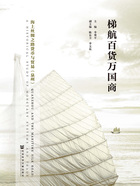
PREFACE
The maritime Silk Road is constitutive of a vast and rich trove of international commerce and trade activities in ancient times that have left an indelible mark on human history. Use for these purposes began as far back as more than two thousand years ago at Xuwen Port and Hepu Port on China’s southeastern coast. Since the Tang dynasty,port cities such as Guangzhou,Ningbo (aka Mingzhou),and Quanzhou (aka Zayton) have one after another grown into important international trading hubs. During the Song and Yuan dynasties,with its trading capacities rendering accessible locations along the coasts of the Pacific and the Indian Oceans,Quanzhou reached its Golden Age and became a world-class port city in the same league as Alexandria of Egypt. It was a bustling place through which vast quantities of silk and China bound for the overseas market and spices and jewelry coming into China from places such as Persia and the Arab world passed. All told,trade between China and nearly one hundred countries and regions around the globe happened in or through Quanzhou over this period. Under the Ming government’s severe restrictions on trade,however,Quanzhou was set on a course of gradual decline. Following the discovery of the New World in the fifteenth century global trade entered a new era of rapid growth and transformation. Foreign trade over maritime routes began to thrive again in Macao,Guangzhou,Zhangzhou (Port of Yue) and Port of Anping,among other places. Growth of China’s international trade,especially with Europe,accelerated since the Longqing reign of the Ming dynasty. Most notably,trade in silver in particular reached unprecedented scale. The vast influx of the metal originating from Europe,the Americas and Japan had significant and long-term consequences for China’s economy,society and monetary system.
Copper was the material of choice for a very long time in ancient China for making coins. Resource availability was one reason,but there were also economic and cultural factors. Silver mining and production was extremely limited. By contrast,copper was abundantly available. Given the particular needs of an agriculture-based subsistence economy,and the profound legacy of the Bronze age,copper was China’s default choice for standard money since coinage first appeared. Traditional casting methods remained little changed for millennia,and only gave way to mechanized minting in the late 19th century when associated technologies from the west became available in China.
One consequence of the brisk growth of trade along the maritime Silk Road during the Tang dynasty was the beginning of silver coinage. In late Tang,boat-shaped silver bullions with a total weight of 50 liang were produced to meet the growing needs of maritime trade. They were used only for trading commodities. In fact,these were the first silver currency used in China. During the time of Song and Jin,expanding domestic and foreign trade facilitated marketization and boosted the monetization of wealth. Once a commodity in its own right,silver became increasingly used as a medium of exchange,i.e.,a form of currency. Nor was the use of silver coinage confined to overseas trade,it was also widely used for purposes ranging from tax payment,savings and transfer of funds in large amounts. Exchange rates and principles of change were established for them in relation to paper currency. The simultaneous circulation of silver coinage,copper coinage and paper currency during the Yuan dynasty would eventually lead to silver’s dominance in the Chinese monetary system. The discovery of the New World and the rise of circumnavigation played a key role in the rapid growth of global trade during the Ming dynasty. The attendant influx of silver into the country had profound ramifications for its fiscal policies and monetary system in years to come. The tax reform implemented by Zhang Juzheng (in which silver was uniformly adopted as the single instrument for all different forms of tax payments),provided a most powerful testament to the establishment of the supremacy of silver as the monetary metal of reference. It became the currency of choice for not only international commercial transactions,tax payment,and savings but also price calculation and daily expenditure.
The maritime Silk Road also helped to expand ancient China’s cultural footprint,especially for Chinese coinage. Coin specimens originating in China have been found in many locations around the world,including those in East,Southeast,South and West Asia,East Africa,Europe and Latin America,among others. Not only were genuine Chinese copper coinage used in countries in some East,Southeast and South Asian countries,imitation coins were also minted. One can hardly overstate the impact of the maritime Silk Road over two millennia on China and the rest of the world. In addition to facilitating the circulation of goods and boosting economic growth,by encouraging cultural exchange it also did much to help people around the world get to know one another.
As the starting point inside China of the maritime Silk Road,the city of Quanzhou has a good deal of valuable experience in trade and cultural exchange,especially during the Song and Yuan dynasties,from which we can learn as we endeavor to implement the “One Belt One Road” initiative. Three points are particularly worth noting. First,Quanzhou,known as Zayton in ancient times,was peace-loving,and everything the city and its people did in their interactions with people from other parts of the world was a testimony to that fundamental fact. Secondly,Zayton was in the vanguard of the Chinese people’s centuries-long effort to build maritime trade routes that are predicated on peace,promote shared prosperity and advance mutual understanding. Thirdly,the experiences of Zayton prove beyond any doubt that differences in core beliefs,ethnic identities and cultural traditions are no obstacle to people building friendships and bonding in solidarity.
Zhou Weirong
Director,China Numismatic Museum
November 3,2017